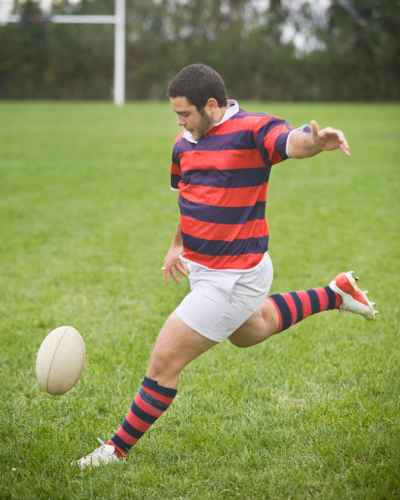The bomb or high kick in rugby league is a high, hanging kick designed to give the attacking team time to chase and contest the ball in the air.
The kicker aims to kick with a high trajectory where the angle gives the most hang time in the air.
This kick is often used to target a specific opposition player, usually a fullback or winger. The kicking team wants to force them to make a difficult catch under pressure from the attacking players.
How Bombs Are Executed
The bomb kick is usually executed by the team’s halfback or five-eighth. Players in these positions train repeatedly to get their technique right.
Here is a rundown of the technique starting from the player with the ball deciding to execute the bomb.
Preparing to kick
The kicker typically runs at an angle towards the sideline or target area. This is to create space from the defenders.
Kickers hold the ball in both hands, pointing it slightly downwards and angling it towards the target area.
Strike and follow through

As the kicker moves forward, they drop the ball from their hands and kick it with their instep or the top part of their foot, just below the laces.
The aim is to strike the lower half of the ball to generate height and hang time.
After making contact with the ball, the kicker follows through with their kicking leg. They point their toes upwards and continuing the upward motion.
This helps maintain accuracy and generate the desired height on the kick.
What Do Teammates Do After A High Kick?
As soon as the ball leaves the kicker’s foot, the attacking players sprint towards the target area to apply pressure on the receiving player.
The wingers and centres are key in this task.
Usually, one player will jump and contest the ball in the air.
The other players tackle the receiver immediately after the catch. The aim is to limit the opposition’s ability to launch a counter-attack or make significant territorial gains.
When Is The Best Time For A High Kick?
The bomb is particularly useful after the fifth or sixth tackle when the attacking team is near the opposition try line.
The team has used up all or most of their tackles so the bomb gives a final chance to put the opposing team’s fullback or wingers under pressure.
The best outcome is that an attacking player beats the defender to catch the ball and scores a try.
But another great outcome is if the defending team is forced to knock the ball dead or commit an error. This gives the team who gave away the ball a repeat set of six tackles.
High kicks from behind the 50 metre line
If the attacking team is in their own half and wants to gain territory, a long bomb can force the defending team’s fullback or wingers to catch the ball close to their try line.
This puts pressure on the receiving player and can result in errors.
Even when the defenders cope well with the high kick, the kicking team can pin the opposition deep in their half with a strong defensive chase.
Spotting a weakness in defenders
If a defender fumbles a high ball or looks ill-at-ease coping with them, you can be sure that there will be plenty more arriving.
Defenders don’t want to get a reputation for being vulnerable under the high ball. Otherwise, the tactic will be a key part of their opponent’s game plan.

Relieving pressure
If the attacking team has been under sustained pressure from a harrying defense, the half-back or five eighth may decide that some of that stress needs to be relieved.
A well-executed bomb can help turn the momentum of the game by forcing the opposition to deal with a difficult high ball and potentially make an error.
The other hope is to catch the opposition by surprise. A bomb kick can be an unexpected tactic when the attacking team has not used it frequently in the match.
How To Defend High Kicks
When a defender catches a high kick, the priority is to secure possession and prevent the opposition from regaining the ball.
After catching the ball, the defender should hold it tightly and protect it from being stripped by the opposition.
They should use their body and arms to shield the ball, making it difficult for the attacking players to dislodge it.
Depending on the situation and the defender’s position on the field, they may decide to counterattack by running the ball back towards the opposition.
Alternatively, they may play the ball to a teammate to start a new set of tackles.
When counterattacking, the defender should look for gaps in the opposition’s defensive line and try to gain as much ground as possible.
When the ball drops close to the sideline
When the kicker puts the ball to either side of the field, the aim is to get it close to the sideline.
That means that the defender must work to ensure they remain within the field of play when catching the ball and during any subsequent play.
If the defender is forced out of bounds by the opposition, then possession is returned to the attacking team.
Good communication
Defenders should communicate with their teammates as the high ball drops.
It’s important that one player calls for the ball so that you don’t have a situation with two defenders getting in each others way.
The catching defender is also directing teammates to provide support or protection from the attacking players.
More About Kicking
High kicks and bombs are aimed with a high trajectory. The 40/20 kick is also high but is aimed to bounce before crossing the side line.
Cross-field kicks in league tend to be long and lateral but not as high as a bomb. In contrast, grubber kicks in league are scudded along the ground.
Check out our article on kicking in rugby league for a rundown of all the types of kicks in the sport.